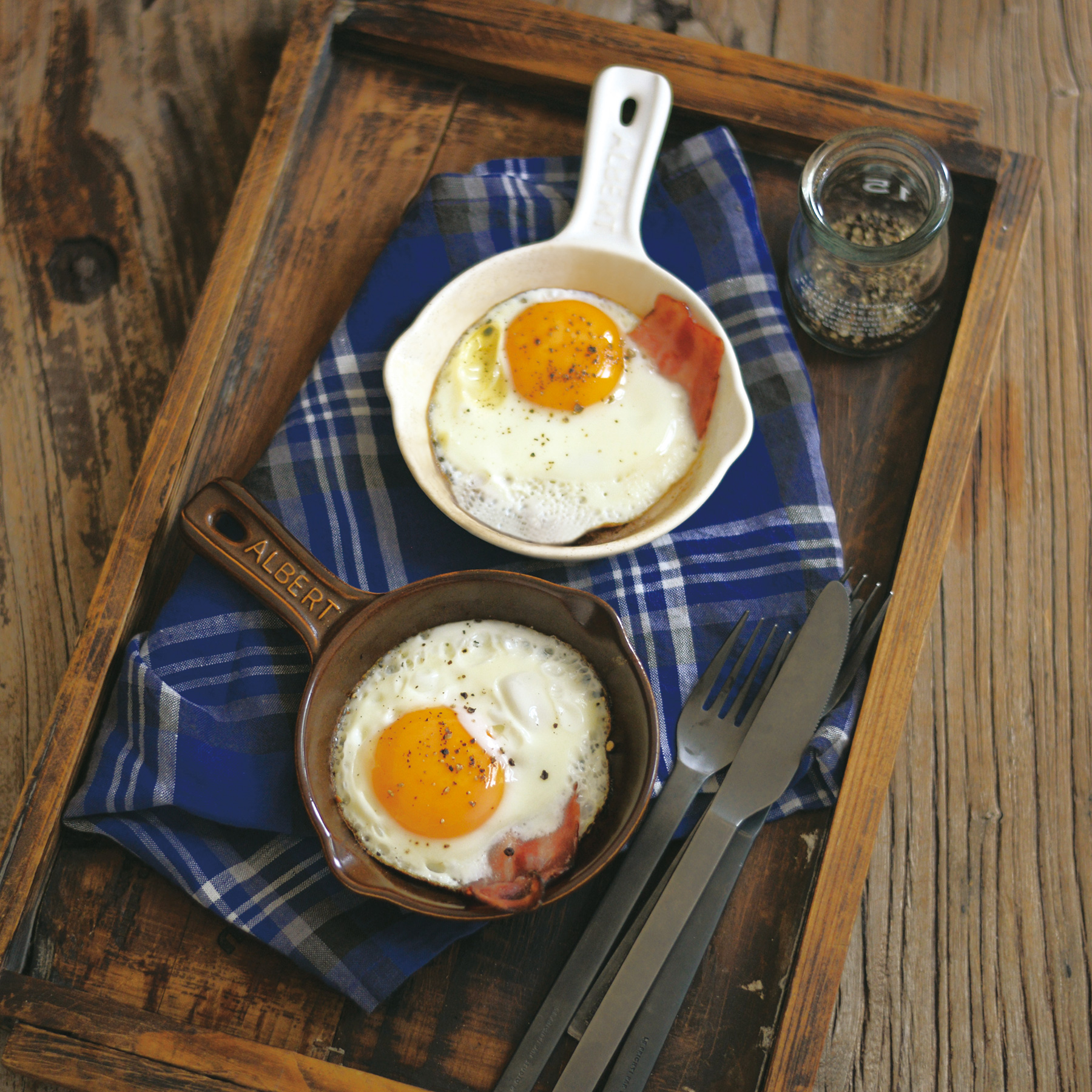アルバート エッグパン アメ
説明
アルバートは人名で料理好きな男性が愛用しているイメージ。無骨なシルエットにハンドルの凸文字がアクセント。直火、オーブンに対応。エッグパンは目玉焼きだけでなく、1人分のデザート型としてもおすすめ。熱々のままテーブルにサーブできるのもうれしい。
商品詳細
色幅
商品の色に個体差があります。季節や気温などの自然条件や、釉薬と焼成する際の火加減によって、器は様々な表情を見せます。同じ素材の器であっても、まったく同じ色に焼きあがることは非常に珍しく、100個あれば、それぞれが違った表情を見せてくれます。
色ムラ
一個体の中で、釉薬や化粧土のムラがでます。1つの器の中において、色の表情が均一ではない箇所がある場合があります。器の形状などにより、釉薬の掛かり方が厚かったり、薄かったりする箇所があることが一つの要因です。それにより土の表情が一つの器のなかにおいても変化を見せます。
釉垂・化粧垂
釉薬や化粧土が垂れたようになる場合があります。釉薬や化粧土を手作業でかけることによるムラや、焼成中の釉薬の流れにより、釉薬がたれた状態になります。
荒土
粒子の荒い土を使用しているため、表面に凹凸がある場合があります。
ピンホール
商品の表面にピンホールが目立つ場合があります。土を主成分とする陶器には、素焼きの段階で器に多くの空気が含まれており、これが焼成時に気泡となって釉薬の表面に小さな穴となって現れます。これをピンホールといいます。
貫入
釉薬部分の細かなヒビが目立つ場合があります。直接貫入は商品に元々貫入が入っています。経年貫入は使用していくうちに入ってきます。素地と釉薬の収縮率の違いによって生じる釉薬部分のヒビのことです。商品本体の破損によるヒビとは異なります。使用前に生じることもありますが、使用上問題はありません。陶器、半磁器に現れます。
鉄粉
商品の表面に鉄粉が目立つ場合があります。陶器の原料となる土には鉄分が含まれており、器を焼くと表面に黒い点となって現れます。赤土や黒土にはより多く含まれているため、その土を利用した器は、より鉄粉が出やすくなります。
電子レンジ対応
電子レンジはマイクロ波で食材を加熱します。多くの場合は水分を加熱しますが、炭化した(焦げた)部分にはマイクロ波が集中し、他の部分より温度が上がる場合があります。例えば野菜炒めの炭化した(焦げた)部分にマイクロ波が集中して、器の中で大きい温度差が生まれ、破損する場合があります。また、水分だけでなく油分も加熱されます。油分の方が水分より沸点が高く、より高温となり、油分の含まれた部分と含まれていない部分に非常に大きい温度差が生まれ、破損する場合もございます
○電子レンジご使用後の熱くなった器を水に浸したり、冷たい調理台に置いたりしないでください。また冷凍食品を入れて急激な加熱や、冷蔵庫から出した器をすぐに電子レンジに入れることはお止めください。急激な温度変化を与えると貫入や破損の原因となります。
※金・銀彩の上絵が施されている商品、特定の釉薬の商品には使用できません。使用できない商品にはシールが貼られていますのでご確認下さい
※付属品など陶磁器以外の素材については使用できません
オーブン対応
○オーブンに入れる前に表面の水分を拭き取ってからご使用ください。
○オーブンから出した後の熱くなった器を、水に浸したり、冷たい調理台に置いたりしないで下さい。また冷凍食品を入れて急激な加熱や、冷蔵庫から出した器をすぐにオーブンに入れることはお避け下さい。急激な温度変化を与えると貫入や破損の原因となります。
○調理の際生じた焦げや著しい汚れ等の洗浄に、金属タワシなどの使用はお止めください。表面が傷つくおそれがあります。
○高温になると器の色が変化する場合がありますが、使用上の問題はありません。冷めると元の色に戻ります。
食洗機使用不可
直火可能
この商品の素材は耐熱陶器です。直火でのご使用が可能です。IH調理器でのご使用はできません。
○ご購入時に表面にヒビ(貫入)が入っているものや、使用していくうちに貫入が入っていくものがあります。
○土の粒子が粗く、器に入れた食品の水分が染み出る事があります。
○乾燥が不十分だと以下の事が起こります。
・火にかけると、器に吸収された水分が側面から染み出て焦げる事がある
・器に水気が残った状態で収納をすると、シミやカビが出来やすくなる
made in JAPAN
※短時間で洗浄が完了する業務用食洗機はご使用いただけます。











